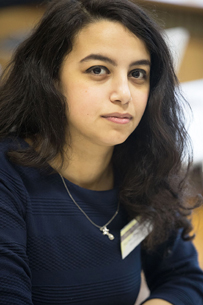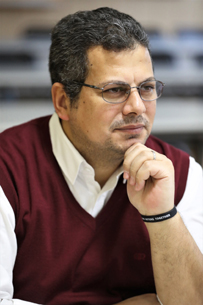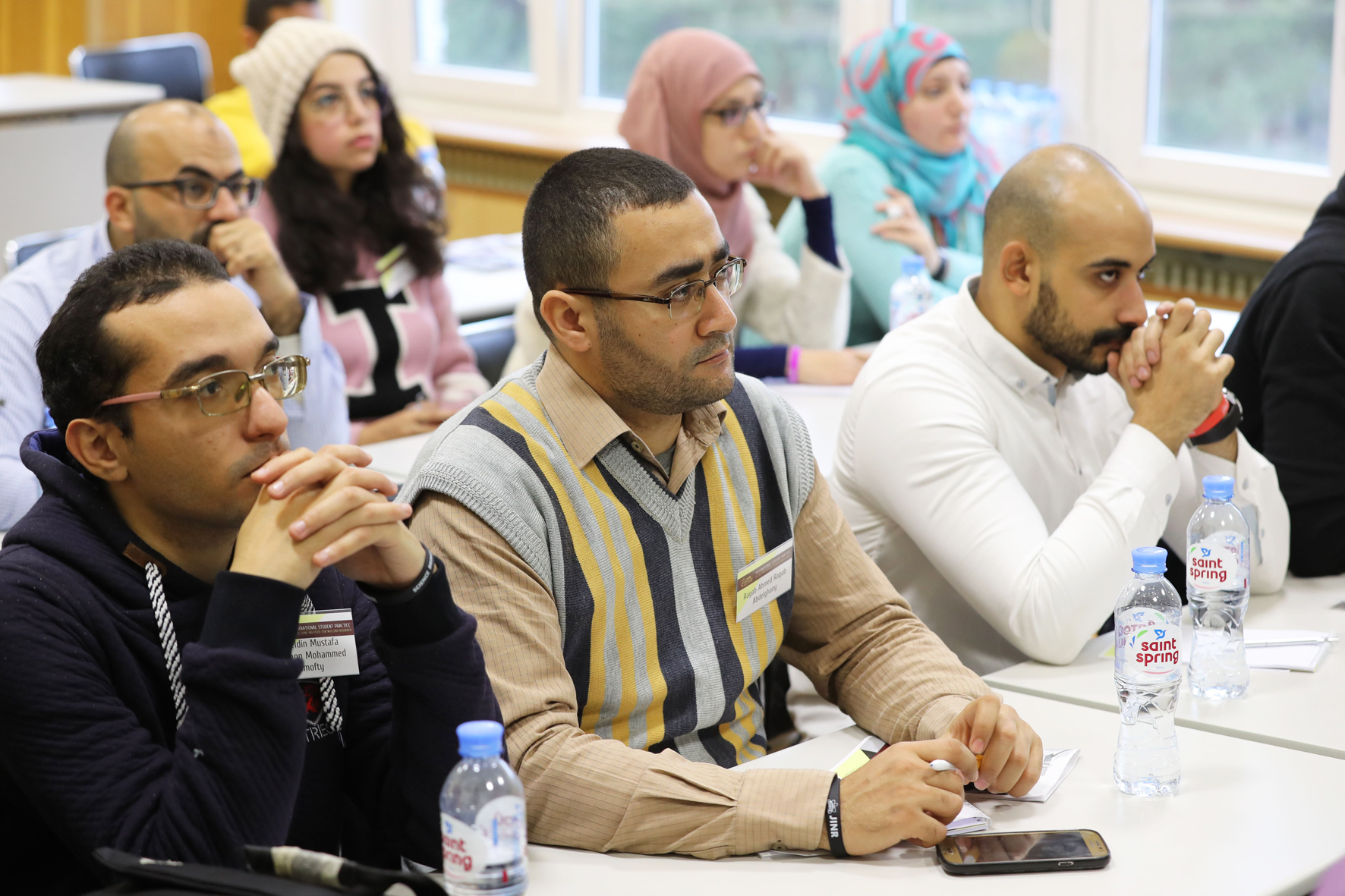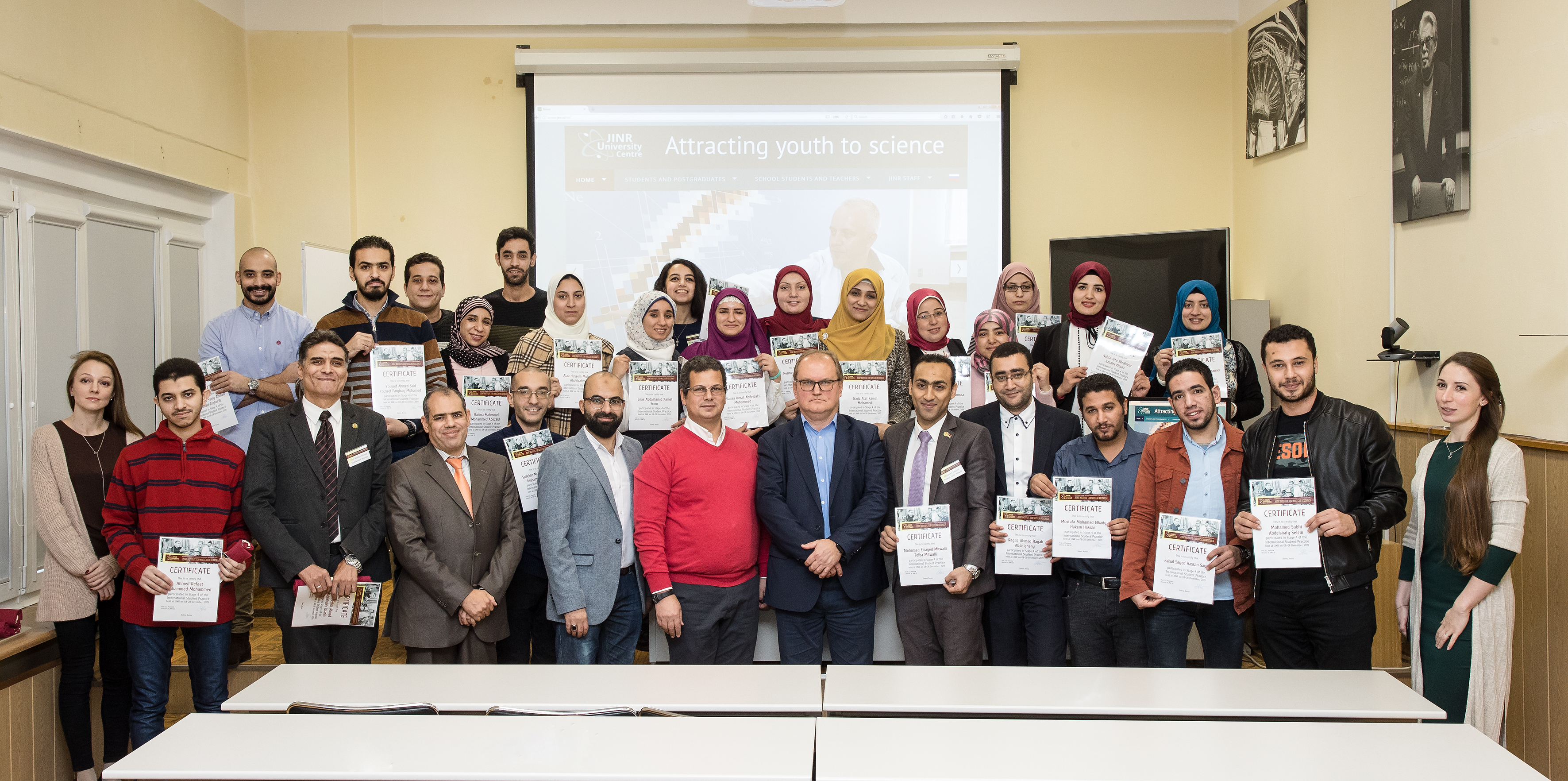Students from Egypt at JINR for 10 years
Education, 15 January 2020
On the last days of 2019, the educational and scientific practice for students and postgraduates from Egypt was concluded. The scientific youth of the country has been learning about research conducted at the Joint Institute for 10 years already. 249 people have participated in practice during this time. Following the tradition, the programme of the present practice comprised lectures by leading specialists from all the Institute’s laboratories, excursions to the basic facilities, and a trip to Moscow.
The bulk of the programme was devoted to work on research projects in the laboratories under the supervision of JINR specialists. On the final day of the practice, 27 December, participants of the Practice showed how successful it was. Some participants and their supervisors shared their impressions of the practice with a journalist of the JINR Weekly Newspaper.
Supervisor of the project “Computer simulation of radiation protection using the Geant4 toolkit” was A. S. Zhemchugov (DLNP): “University specialization of Alaa Abdelrahman did not fully correlate with the topic of the chosen project because she is a chemist and works in a group engaged in computational chemistry, modelling of the behaviour of long molecules. She was interested in mastering this tool to apply it in tasks of radiation chemistry. The task I have given to her was connected with the Geant4 toolkit, a set of software programmes for modelling interactions of nuclear radiation with the matter. It is a traditional instrument of particle physics. However, it has been actively used in all applied fields, such as medicine and material science, for the last ten years or so. There is an extension that allows modelling damages of biological tissues. As I understand, Alaa wants to create something similar in Egypt using this instrument. It was her first acquaintance with it, and it was a challenge for her as far as being a chemist she knew not so much about nuclear physics, she did not know any programming languages as well. So, we had to start with not physics but writing simple software programmes because, unfortunately, this software pack demands of the user to write the programme on his own.
It was difficult to learn everything in three weeks but she succeeded to do it: she developed a simple programme, obtained some reasonable results using it, so she solved a fairly simple task but she did it to the full extent. It was not connected with radiation chemistry or any molecules. The student was supposed to count how much energy was left after the energy passed through a small sample, to calculate the particles that went in and out of it. These were simple basic issues but it was enough for the first acquaintance with the field.”
Anastasia Ivanova and Artem Russakovich (DLNP): “Our project on genomic “dactyloscopy”, on the creation of the genetic passport of a person included many stages. Students were focused on work, asked for additional information. We are biologists in the institute of physicists. We always teach biological techniques, they should be explained from the very beginning. These techniques allow working with DNA, monitor its state, partly change it. In this project, we focused not only on work conducted here but on introducing more methods and techniques to students. They performed the bulk of the tasks using the samples of their own DNA. They got their DNA samples from the blood, studied them and learned some of its characteristics. They had a biological specialization, so they knew the basics. Physicists take part in our practice as well but we have to explain to them many issues from scratch. This time it was easier for us.”
Youssef Ahmed: “Everything was useful for us. Even when something went wrong, there were reagents to repeat the work. The clearly developed plan of the programme covered a large number of methods. Moreover, some extra visits were organized in addition to the main programme of the practice.”
Ali Elghareb: “It was an outstanding experience: we spent three weeks in such a prominent Institute, one of the leaders in the field of nuclear research. It would be useful for me to visit it once again.”
A. B. Arbuzov (BLTP) supervised the project “Theoretical description of quasi-elastic neutrino-nucleon scattering”: “Of course, three weeks are not enough for the task, but Marwa Selim showed a particular progress, and, in fact, she already knew some basic issues. However, it was true only for mathematics and general physics, and she did not have basic knowledge of quantum field theory. So, we had to start with basic things to solve our task. Our project was aimed to consider a so-called problem of reactor antineutrino: we know well physics of a nuclear reactor, we know for sure how much energy it provides and we can accurately calculate how many neutrinos are emitted. Then, we experimentally check how many neutrinos we see, the detector is placed near the reactor. The number of observed neutrinos is less than expected for about 5 per cent. This problem has been known for more than 10 years, and there are still no rational descriptions in the frames of standard physics. We may assume the existence of sterile neutrinos, and such an effect will be possible but then it is necessary to find those sterile neutrinos.
We tried to find the effects that were not taken into account. In particular, the effect of radiation corrections in measurements, neutrino observations. We have estimated that there may be amendments of the order of one per cent, and may be of two, three, four per cent in the necessary direction, these are subtractive corrections. We figured out what to do, and, in fact, it resulted in the statement of the task but not its solution. Months of work of qualified specialists will be necessary to solve the task we wanted to solve. It is a considerable experience for a student as well as far as he is engaged in real work. It is a chance to understand something, to do maybe simple but necessary tasks for the project. We got some preliminary estimations and hope that we will cooperate in the future.”
 Marwa Selim: “It was not that difficult; there was just not enough time to understand the object of research and obtain results. I have graduated from university and work as an assistant researcher in the field of theoretical physics. This project opened a new “window” to physics for me.”
Marwa Selim: “It was not that difficult; there was just not enough time to understand the object of research and obtain results. I have graduated from university and work as an assistant researcher in the field of theoretical physics. This project opened a new “window” to physics for me.”
“And your words at the end of the presentation “Neutrino physics is very interesting” were sincere?”
“Yes, they were. I was engaged in nuclear physics, studied particle physics. However, neutrino physics turned out to be the most interesting field for me.”
“Will you continue research in this field?”
“I have discussed it with the supervisor, and now I am trying to choose between gravitational physics and high energy physics.”
A. V. Uzhinskiy (LIT): “At first, our project was aimed to detect plant diseases using deep neural networks. The main inspirer of this project was Gennady A. Ososkov. He delivered a lecture for the participants of the practice and we were on standby. Three students took part in our project. They learned a lot, in fact. I already worked with students two or three years ago, and they were worse trained. Participants of the present practice had fairly good basic knowledge in this particular research area, some of them were even quite good in it. I appreciated their enthusiasm. We just gave them directions, and they immediately started to puzzle everything out.
We were originally aimed to acquaint them with the project. It gained support from the RFBR two years ago; we started to work on it and obtained good results. Students were supposed to repeat our experience using our database of images, ready scripts in order to produce models etc. They outgrew it pretty quickly. Each of the students having been acquainted with our experience was supposed to choose an agricultural crop and thus expand the model. During the acquaintance with the activities of our laboratory, I told them about a joint with FLNP project implemented in the frames of the UN programme ICP Vegetation. In the frames of research in the programme, participants collect moss samples. They cannot always determine the type of the collected moss. So, there was a practical task to determine the moss type. Students enthusiastically took up it. They got interested in it. So, as a result, they performed the task together. We showed them automated means for the data collection, i.e. for the creation of the database of images, and chose five types of moss. In the end, they managed to create a fairly good model able to solve these tasks. We have partially integrated it in our application. They went through all the stages they could and even more. I think they liked it as much as to continue to work on it. They understood how our algorithms operate, how to improve them, and developed something real just in three weeks. It is an excellent result. There was not much time left to prepare the presentation. But they succeeded to do it as well.”
Asem Alaaeldin: “We listened to the theoretical introduction to deep machine learning, were acquainted with peculiarities of the architecture, special functions, and then started our practical work. We applied the general software programme to determine diseases of plants. We also attended a useful workshop on moss classification, were acquainted with various techniques, including high-performance computing technologies, with the help of the team from the Division of Computer Communications and Distributed Information Systems of LIT. We are very grateful to them. We were taught to work with data, filter it and obtain high-quality data sets that meet the needs of machine learning. I am very impressed with the practice, the team of Professor Ososkov! I thank all of them! We hope to meet in the future if there is an opportunity.”
 Wael Badawy (FLNP) spoke about the selection of participants in Egypt for this practice: “When we announced the practice in Egypt, more than 400 people expressed their wish to participate in it. The Academy of Sciences decided to carry out an additional selection. 60 students were selected out of 400 pretenders via a special interview. Then, 25 students were left after the survey. It is interesting that there were applicants representing universities and scientific institutes from various parts of our country, not only Cairo and Giza. This year, we sent to the Academy the list of educational research projects in advance to make it possible to choose particular projects rather than general topics as it was before. We discussed with the leaders of all the projects in the laboratories their readiness to take part in the practice as far as this stage was held in December and ended just before the New Year. Fortunately, a large number of supervisors was ready to work.”
Wael Badawy (FLNP) spoke about the selection of participants in Egypt for this practice: “When we announced the practice in Egypt, more than 400 people expressed their wish to participate in it. The Academy of Sciences decided to carry out an additional selection. 60 students were selected out of 400 pretenders via a special interview. Then, 25 students were left after the survey. It is interesting that there were applicants representing universities and scientific institutes from various parts of our country, not only Cairo and Giza. This year, we sent to the Academy the list of educational research projects in advance to make it possible to choose particular projects rather than general topics as it was before. We discussed with the leaders of all the projects in the laboratories their readiness to take part in the practice as far as this stage was held in December and ended just before the New Year. Fortunately, a large number of supervisors was ready to work.”
“You also supervised the project «Neutron activation analysis for life sciences»…”
“I had two students engaged in the project. I agreed in advance the programme of work with colleagues from the sector. They delivered lectures, each of them on his own specialization. Despite the fact that students were acquainted with the topic for the first time, they showed great interest. We gave them many additional materials to study, conducted an excursion to the REGATA facility at the IBR-2. They visited the chemical laboratory where we prepare samples, learned about all the stages of their preparation at moss samples. They carried out a small part of experimental work by themselves, studied all necessary software, programmes for calculating concentrations, made their presentations and successfully performed with them.
When I asked them about prospects, they expressed their interest to join the projects with which they could come here for a longer period of time and use this experimental work to write dissertations in Egypt in the frames of the collaboration.”
Olga Tarantina, JINR Weekly Newspaper
photos by Igor Lapenko

